Articles
Men, Women and Machines:
Time Management and Machine Dictation in the Modern Office
Abstract
For almost a century, machine dictation was promoted by equipment suppliers and efficiency experts as an element in the systematic reorganization of document production in offices. This reorganization focussed on: establishing a hierarchical (and in practice a gendered) division of labour; measuring and optimizing the time required to perform job tasks; and designing unimpeded, one-way work flows where face-to-face interaction was minimized. Suppliers promoted machine dictation as a means to eliminate shorthand dictation and increase typists' rate of output, therefore reducing clerical labour costs. In addition, managers would spend less time in dictation and would be free to compose documents when they wished. Machines were initially based on the wax cylinder phonograph, but manufacturers after the Second World War introduced a number of technical innovations. Despite these developments, machine dictation proved less popular than promoters had hoped. Demand stagnated due to the difficulty of acquiring the necessary dictation skills, the enduring attraction of handwritten drafts, and the unrecognized benefits of dialogue between dictator and stenographer during the creation and preparation of documents. With the advent of desktop computers, direct keyboard entry by writers eliminated one of the main justifications for machine dictation.
Résumé
Pendant près d'un siècle, les fournisseurs d'équipement de bureau et les experts en productivité ont fait la promotion de la machine à dicter en tant qu'élément d'une réorganisation systématique de la production de documents dans les bureaux. Cette réorganisation favorisait une division hiérarchique (et, en pratique, selon le sexe) du travail, la mesure et l'optimisation du temps requis pour exécuter des tâches et un déroulement du travail unidirectionnel et sans obstacle, à l'interaction en tête-à-tête minimale. Les fournisseurs présentaient la machine à dicter comme un moyen d'éliminer la prise de notes en sténo et d'accroître la cadence des dactylographes, réduisant ainsi les coûts du travail de bureau. Ils avançaient aussi que les gestionnaires allaient passer moins de temps à dicter et seraient libres de rédiger des documents au moment qui leur conviendrait. Initialement, les machines consistaient en un phonographe à cylindre de cire, mais après la Seconde Guerre mondiale, les fabricants ont introduit un certain nombre d'innovations techniques. Malgré ces changements, la machine à dicter a été moins populaire que ses promoteurs ne l'avaient espéré. La demande a stagné en raison de la difficulté d'acquérir les habiletés à dicter, de l'attrait persistant des brouillons à la main et des avantages méconnus du dialogue entre le dicteur et la sténographe lors de l'élaboration et la préparation de documents. Avec l'avènement du micro-ordinateur, la saisie directe parla personne qui rédigeait un texte a fait disparaître l'une des principales raisons d'être de la machine à dicter.
1 The Audograph was a dictating machine introduced by the Gray Manufacturing Company shortly after the Second World War.1 Like many such machines, it was actually sold in pairs, one for dictation and one for transcription. Looking at surviving examples of the two units, we can see subtle differences and similarities. Each is housed in a metal cabinet whose rounded corners, simple chrome grille, three-tiered elevation and gray-brown crinkle finish convey a sober, modern, almost military solidity. The business end of the machine, the head where the record or reproduce stylus contacts the thin vinyl disk, is hidden from view and engaged by throwing a lever. No further adjustment is required by the user (Fig. 1).
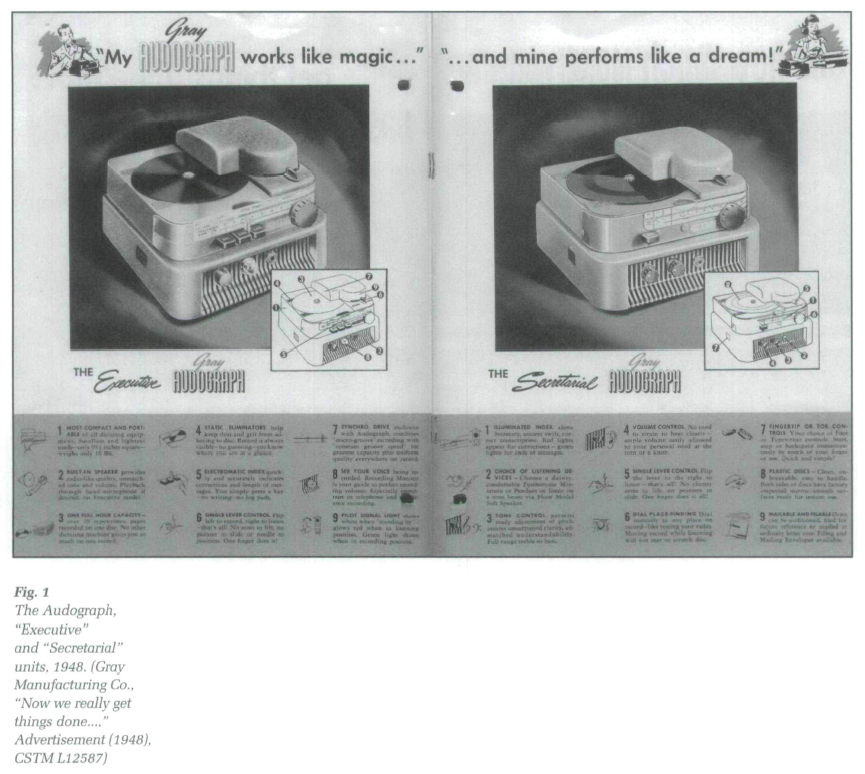 Display large image of Figure 1
Display large image of Figure 12 The most visible and most interesting elements of the Audograph are the control and indexing features. These can be grouped into three subsystems. In the top tier of both units is the lever controlling the record/reproduce head. In the dictation unit the user, typically a male executive, can switch between "RECORD" and "LISTEN." In the transcription unit, the user, typically a female typist or secretary, has only one option: "LISTEN." In the bottom tier of the dictation unit, the user has one knob that controls the record and playback sound level, aided by a light that indicates the volume. On the particular model I examined, someone has helpfully marked a line with red crayon, probably indicating the preferred sound level. In the transcription unit, the user has two options, a volume control and a tone control.
3 The third subsystem is the indexing feature that comprises the middle tier of both units. Before recording, the "dictator" (as he is called in the operating manual) inserts a twenty-four centimetre long, perforated paper strip behind a plastic guide so that the perforations at the far left engage a toothed wheel. This wheel is coupled to the assembly that draws the rotating disk under the stationary record/reproduce head so that as the record advances, the strip is advanced from left to right. In the process of recording or listening, the dictator can mark the index strip in several ways. To indicate the end of a discrete recorded document he presses the "END" button, which punches a hole in the strip. To indicate special instructions or a correction to something already recorded, he presses a "COR." button, which punches another hole. With a pencil he can also indicate, among other things, his name, the date of the recording and the location of priority documents on the recording. In this way, the point in time that various events occur during recording is recorded in graphic and linear fashion on the index strip. As well, contextual information about the recording is provided by a visual code.
4 For transcription, the typist places the disk on her machine and inserts the index strip so that it engages the toothed wheel. Aided by the information encoded on the strip she knows who has made the recording and when, the number and relative duration of the separate "documents," and whether there are out-of-sequence corrections or other recorded instructions that will affect a passage she is typing. If she has difficulty understanding the dictator she can adjust the volume or the tone of reproduction or stop, back up the disk and replay the passage. In theory, she has all the information and tools to transform the recorded speech of the dictator into written documents. She and her dictator need never meet face to face nor engage in dialogue in "real time."
5 Machines are designed to solve problems. These can be understood in pragmatic terms. For example, how does one design a recorder and reproducer system that can eliminate the time-consuming process of creating typed documents from personal dictation or handwritten drafts? How does one design a system that, without benefit of face-to-face dialogue, provides all the auditory and visual information needed to accurately capture and format the author's intentions? Many of the mechanical features of the Audograph embody the practical problem that occurs when a collaborative, face-to-face dialogue is replaced by a sequential process carried out by isolated individuals. But the Audograph embodies more than this problem. It also embodies the troubled relations between the groups of people in the modern office who were charged with producing correspondence and other documents. As Steven Lubar has argued, "machines are the material culture of politics." Through machines, conflict between groups in society is expressed, negotiated and, at least tentatively, settled.2 While this conflict can be overt, as in a labour dispute over the introduction of automated machine tools in a factory, it can also manifest itself in more subtle ways. For example, operators might not use the machine in the way it was intended by the maker or the owner. They might use it reluctantly, or if they have sufficient control over their work, infrequently or not at all. In other words, conflict might appear simply as a system not working as well as it was supposed to.
6 The dictating machine was conceived as the solution to problems arising from the division of labour between managers and clerical staff in the creation and preparation of documents. But as we shall see, this solution created its own problems. Practical mechanical and communicative difficulties from working within machine dictation systems often led to resistance to using the machines by both managers and clerical workers. In both the conception of the solution to document production, and in the expression of conflict over that solution, the theme of time is recurrent. Dictating machines were promoted as means of making more economical use of labour time. The machines themselves suspended the flow of time by recording speech for later transcription. And the machines restructured a temporal process that once involved at least some simultaneous dialogue into one that dictated sequential and independent action. The limited success and more recent decline in the fortunes of dictating machine suppliers in Canada can be attributed to the imperfect way that the machines resolved these issues.
7 In the history of communication technologies of the last century and a half, the dictating machine is a minor phenomenon. With some justification it has not received the scholarly attention of such interactive systems as the telegraph, telephone, or the Internet or of such mass media as radio broadcasting, television or recorded music.3 Dictating machines rumbled away in obscurity in the offices of lawyers, banks and insurance companies, eliciting little comment outside the pages of office management journals. The machines were never used by a majority of office workers, and since the 1970s their impact has been overshadowed by newer technologies. One historian of technology even assigns dictating machines a prominent place in a Web site devoted to "Dead Recording Media."4 Though not in fact dead, dictating machines have not become as ubiquitous as their promoters had hoped. This alone makes them worthy of study, but they can also tell us a great deal about the evolution of office work and business communication. The measurement and management of time spent in this work has been central to the history of machine dictation.
8 This paper will investigate the technical and social history of dictating machines. While an authoritative study would ideally include a close reading of many objects, I have chosen a more traditional documentary approach to this research. Objects are not fully legible without an understanding of the contexts in which they were designed and used. While objects can reveal some of this context, written texts remain rich sources that must be addressed. For this paper I have made extensive use of trade journals, manuals, advertising and office management handbooks. As well, I have drawn on an extensive secondary literature in the history of labour and business.
Time, Work Flow and Machine Dictation
9 Like all sound recording devices, the purpose of the dictating machine is to convert sound waves into a semi-permanent pattern in a physical medium that can be stored and later "played" to regenerate the original wave pattern. Thomas Edison was the first to demonstrate this system, designing a device in 1877 that used a stylus attached to a vibrating diaphragm to indent undulating grooves in tinfoil. In 1878, Edison proposed several applications for his phonograph, including the preservation of languages, the reproduction of music, and the production of a "registry of sayings, reminiscences, etc. by members of a family in their own voices, and of the last words of a dying person." Yet Edison also suggested far more mundane applications for his phonograph, including telephone recording and "letter writing and all kinds of dictation without the aid of a stenographer."5 When the time came to sell the phonograph as a commercial product, rather than a technological novelty, Edison and his competitors advertised it as an office machine. Rather than long-term preservation, the objective was to control the flow of events in the short term. And rather than an end in itself, the recording was merely a means for effecting written communication (Fig. 2).
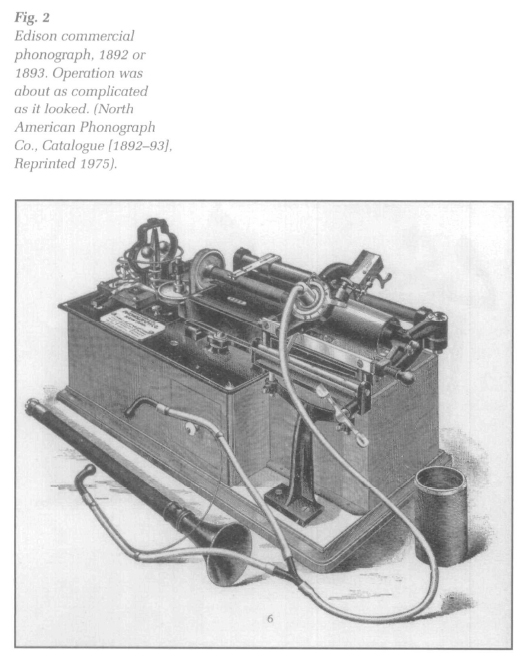 Display large image of Figure 2
Display large image of Figure 210 The dictating machine was one of several technological innovations that accompanied a thorough reorganization of office work that began in the last quarter of the nineteenth century. Faced with the increasing volume of office work and the growing number of office workers, business owners sought means to control the cost and the output of this new administrative apparatus. Much of this effort was focussed on reordering and controlling the communication process within firms and between firms. Owners and managers did this by applying the same rules of division of labour and specialization that were being applied in factories and railways, by rationalizing procedures so that actions required little judgement or discretion for most employees, and by introducing new technologies into the office.6
11 As the production of documents (correspondence, reports, memoranda) was one of the most important activities in offices, much of this innovation took place in stenography. Where once the capitalist might have penned his own letters or given a handwritten draft to a male clerk for recopying, by 1900 document preparation was increasingly performed by women working at typewriters. In the early stages of industrialization, clerks frequently had been trusted, semi-managerial employees who might aspire to ownership positions themselves. Increasingly, secretarial work became a dead end, defined by its lack of control over the definition of tasks, by the narrow confines of a job description, by the lack of promotion opportunities, and, finally, by its gendering as female labour. While it was true that there remained gradations of skill and status, descending from secretary through stenographer to typist, the thrust of office reorganization was to make tasks as routine and mechanical as possible, so they could be performed by workers with the least skill possible. In the production of documents, the most important aspect of this was the separation of document composition, a creative process carried out by managers or executives, from document preparation, a mechanical task carried out by stenographers or typists.
12 The problem with this division of labour was in making the link between creation and preparation. There were basically two options: either the manager could produce a handwritten draft for copying by a typist, or the manager could dictate a draft. Before the introduction of the office phonograph, effective dictation required a stenographer skilled in shorthand. Promoters of the dictation machine, on the other hand, claimed their product was more efficient than either of the other two methods. Central to this claim was their analysis of the time spent in both the creation and preparation processes. Advocates of machine dictation argued that both initial recording and later transcription took less time than composition and typing via longhand drafts or shorthand notes. Moreover, unlike face-to-face dictation, which required the simultaneous presence of dictator and stenographer, machine dictation was part of a sequential process. Dictation could take place when it suited the dictator and without interrupting the stenographer's other work.
13 An early catalogue for the North American Phonograph Company outlined themes that would characterize dictating machine marketing over the next century—speed, simplicity, convenience, control, and the reduction in clerical costs and skill requirements:
- SPEED.You can dictate as rapidly as you please, and are never asked to repeat.
- CONVENIENCE.You can dictate alone, at any hour of day or night that suits your convenience.
- SAVING OF OPERATOR'S TIME.During dictation operator can be employed with other work. Operators make twice the speed in writing out that is possible from shorthand notes.
- ACCURACY.The phonograph can only repeat what has been said to it.
- INDEPENDENCE.You are independent of your operator. It is easy to replace a typewriter operator, but a competent stenographer is hard to find.
- ECONOMY.The cost of an outfit added to salary of operator is less than that of a stenographer and results obtained far superior.
- SIMPLICITY.The method is so simple that no time need be lost in learning it. You can commence work AT ONCE.
- TIRELESSNESS.The phonograph needs no vacation. Does not grumble at any amount of work.
- PROGRESSIVENESS.The most progressive business houses are now using phonographs, and endorse them enthusiastically.
- SUB-DIVISION OF LABOR.In cases where you have a number of letters or a long document, necessitating several cylinders, same can be equally distributed among your typewriters, a saving of both time and labor.7
14 Mr. "Johnson," a fictional court reporter in a 1900 publication of Edison's National Phonograph Company, argued that the phonograph saved time and allowed better management of time for authors and stenographers. "The time of the employee in taking notes is entirely wasted," he told a friend, "for if the dictator were talking to a machine instead, the amanuensis would be engaged in transcribing something else, or doing other work... [T]he Phonograph gives both dictator and transcriber absolute liberty as to time."8
15 This "absolute liberty as to time" was achieved, at least theoretically, by designing machines and procedures that eliminated the need for dictator and stenographer to communicate face to face. An 1899 catalogue of an Edison distributor described the actual mode of operation of the office phonograph. In dictation, the speaker could pause at any time by lifting the recorder lever. In transcription, the typist could control the speed of play to match typing ability and could stop, return and playback difficult passages. The phonograph was a "silent and patient amanuensis." The only special effort on the part of the dictator was to "articulate distinctly." There was no possibility for dispute over the final transcript because the dictator's intent could be "proven by the record itself." The exchange of words that would take place in face-to-face dictation was replaced by an exchange of physical media. The dictator placed the recorded cylinders in a box for retrieval by the typist, who would later give the finished letters to the dictator.9
16 In fact, so mechanical was the process of transcription from recordings that manufacturers likened machine dictation to an uninterrupted flow from author's mind to finished document. A 1907 Edison advertising circular captured this claim in the slogan "From brain to type."10 The switch from shorthand dictation or longhand drafts to machine dictation was seen to be a natural, simple process. Edison's fictional stenographer suggested mat dictating without mistakes or changes was simply "a matter of habit." With practice a dictator could "form the words in his mind, so as to utter them rapidly, without correction."11 To gain maximum benefit from the new system, though, dictators would have to make some behavioural changes. Machine dictation "would force them to think, before beginning to talk; to put their language in proper form for expression and not leave the auditor to imagine from their disconnected words what they really mean to say."12 As we shall see, the degree to which executives and stenographers need bend their behaviour to the requirements of the recording system would influence how fully machine dictation was employed in offices.
17 The rhetoric of the dictating machine manufacturers was consistent with that of office efficiency experts, who embraced machine dictation as part of a larger effort not only to mechanize but to reorganize offices along "scientific" lines. First, they put great emphasis on a systematic division of labour. Echoing Frederick Winslow Taylor, chief proponent of "scientific management" in factories, Lee Galloway in 1919 argued for a clear separation of departments for "thinking and planning" and departments for "doing." This would apply to the production of correspondence, where "the ability to compose a letter is in no way dependent on the skill required to write shorthand or to transcribe from notes or from a dictaphone."13 Second, the experts mimicked the plan of factories by rearranging space and scheduling and routing work to ensure a direct and uninterrupted flow through all phases to its completion.14 The main objectives were to eliminate "backwash, overlapping and, lost motion" and reduce time spent by office personnel in superfluous dialogue.15 While in the past personal interaction was the executive's primary means of contact with employees and customers, this was replaced in the "up-to-date" office of the 1920s by "the smooth-running, high-speed, automatic machinery of facilitation."16
18 Galloway advocated the centralization of all stenographic functions in a single department so that the workload of the entire company could be allocated wiui least redundancy, so that consistent standards could be adopted, and so "adequate inspection and supervision" could be ensured. He recommended elaborate systems for quantifying the output of typewriter "operators," producing daily reports, and assigning work to meet fluctuating demand. He also favoured the standardization of letter formats and recommended that the author dictate all paragraphing and punctuation. This ensured that the stenographer had no discretion in the creation of documents, that her role was restricted to recording (if no machine was used), listening, and typing.17
19 While "scientific management" was primarily about control of the labour process and the appropriation of all "thinking and planning" activities by management, mechanization could play an important role in tins process. For example, dictating machines made it easier to measure stenographers' output, because their work was reduced to simple transcription. With face-to-face dictation, the stenographer had no control over the time she spent with the manager, meaning that she could not be held accountable for her rate of output.18 The dictating machine also enforced the division of labour between "thinking and planning" and "doing." The preparation of documents could be reduced to an almost fully mechanical ideal. In the words of W H. Leffingwell, the dictating machine was "an accurate and impersonal agent" that recorded "every word the dictator utters, and allows for the freedom of creative thought." The dictating machine enabled "the automatic catching of thought from the tip of the tongue."19
20 Both Galloway and Leffingwell assumed that the dictator of office documents was male and that the transcriber was female. Although this gendered division of labour passed without comment, there appears to have been some underlying unease about the mingling of men and women in offices and about the necessity for communication between them. Leffingwell's promotion of the dictating machine as an "impersonal agent" may reveal, or be intended to exploit, a discomfort felt by a male manager in sharing his thoughts and their ultimate expression with a "variable" female stenographer. With a dictating machine, on the other hand:
21 The ultimate goal of scientific management was not control for its own sake but the pursuit of profit by the "saving of time and money." With the use of dictating machines, this came from a reduction in the time needed to record the author's intentions and type them up in a finished document. Not only did machine dictation reduce the clerical time needed for correspondence, but it saved the executive himself "precious hours which may be devoted to constructive planning." In addition to saving time, the dictating machine would also expand time available for composing documents, because it was "available regardless of time or place."21 These themes were repeated in the promotional literature of manufacturers and the semi-promotional literature of the business press throughout the post-Second World War period of rapid growth in office-related economic activity. As well, they were reflected in the changing details of product design.
Developments of the Postwar Era
22 The technology of machine dictation changed very little in the fifty years before the Second World War. Although design changes had simplified operation and improved reliability, dictation was still recorded on a wax cylinder (Fig. 3). Until the 1930s cylinder machines were equipped with neither microphones nor electronic amplifiers, depending solely on mechanical vibration to register and reproduce sound waves. The North American industry was dominated by the same two companies that had established it, Dictaphone Corporation, which was directly descended from Columbia Graphophone, and Thomas A. Edison Incorporated. This long period of stability came to an end with the war. In the postwar decades, three waves of innovation swept over the industry.22
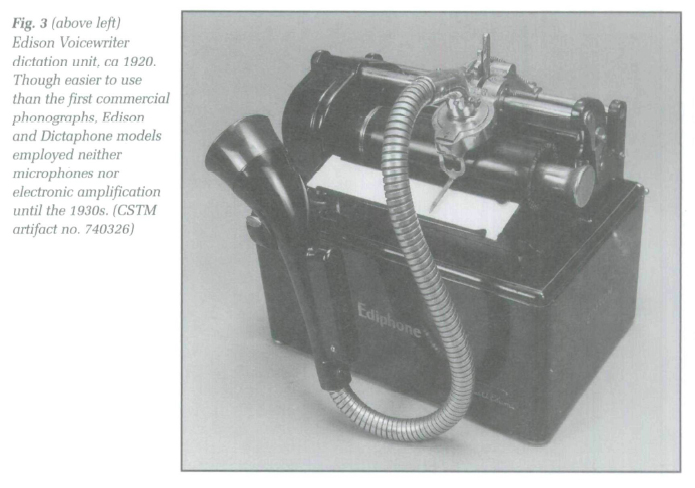 Display large image of Figure 3
Display large image of Figure 3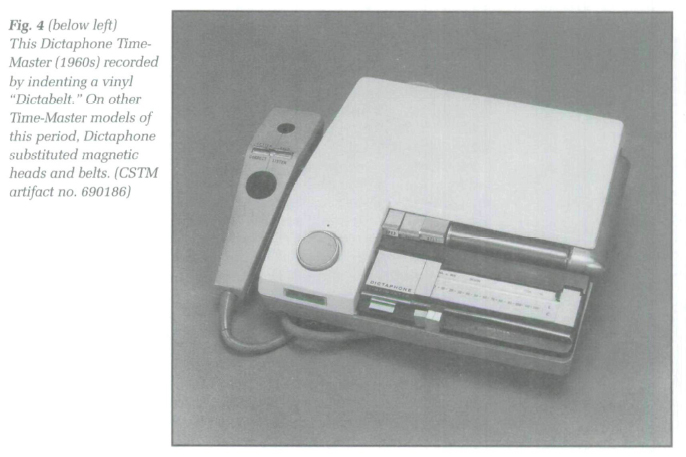 Display large image of Figure 4
Display large image of Figure 4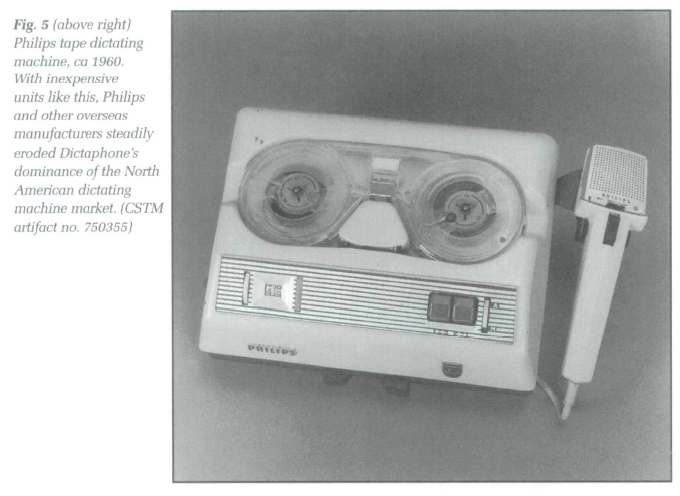 Display large image of Figure 5
Display large image of Figure 523 The first wave saw the demise of the fragile and bulky wax cylinder. In 1944 a newcomer, SoundScriber Corporation, introduced a machine whose stylus indented grooves in small, thin disks made of a new material: vinyl. The SoundScriber was soon followed by the Gray Manufacturing Company's Audograph, Edison's disk Voicewriter and Dictaphone's Time-Master, which recorded by indenting a flexible vinyl sleeve called the Dictabelt (Fig. 4). All production of cylinder machines ceased in the early 1950s. Stylus-type machines recording on plastic disks and belts of various dimensions remained on the market until the 1970s. On the strength of these machines, Dictaphone sold seventy percent of all dictating units in Canada in 1960. Its dominance was soon challenged, however, by other companies selling new technology.23
24 The second wave of technical innovation, magnetic recording, began at almost the same time as disk and belt recording but took longer to crest. Magnetic recording was invented around the turn of the century, but technical problems kept it from widespread use until decades later.
25 By the 1930s dictation recording on steel wire was well established in Europe but still experimental in North America. During the Second World War large numbers of wire recorders were produced for the Allied forces. Production continued after the war, but dictation on magnetic media did not become widespread until the 1950s, after wire had been replaced by plastic tape coated with particles of iron oxide.24 By 1960, a number of inexpensive magnetic tape dictation machines were available in North America, many of them produced by European manufacturers like Philips and DeJur Grundig (Fig. 5).
26 One interesting feature of the magnetic dictation machines was the utter lack of standardization in recording formats. Manufacturers appear to have quickly decided that business users could not be bothered with threading tape reels. For this reason, a wide variety of self-threading or pre-threaded cartridges and cassettes were introduced. In addition, several manufacturers employed magnetic disks and belts, and at least one used a letter-sized magnetic sheet. Like the various stylus-based disk and belt media, each of these formats was proprietary, so that users were locked into a relationship with one supplier.
27 Unlike the stylus-type models, magnetic recorders did not produce a visible record of the dictation, which made it difficult to locate individual segments for review and transcription. As well, taped dictation could be accidentally erased. On the other hand, ease of erasure was also an asset, as corrections were easily made by rewinding and recording over errors. As well, the magnetic medium could be reused many times, thus eliminating a recurring cost. Finally, magnetic recorders offered longer recording times and, some would say, better sound quality. By 1970 only two companies, Dictaphone and Edison, still offered stylus-type belt or disk recorders. Of the top four companies in Canada in 1971, Dictaphone, Philips, DeJur, and IBM, all but Dictaphone focussed exclusively on magnetic recorders.25
28 The third wave of innovation occurred in the 1960s and 1970s and focussed on compact, standardized tape cassettes. At the same time, transistorized and then integrated circuits produced lighter and more compact devices. The first important tape development was the Philips "compact cassette," introduced in 1963. This was followed in 1968 by the "mini-cassette," which Philips incorporated into a full-line of portable, desktop and central dictation devices. On the strength of the mini-cassette, Philips by the mid 1970s had captured fifty percent of the Canadian market for dictation equipment. By this time several other European and Japanese manufacturers were offering machines employing the mini-cassette, Sony's "micro-cassette" or the original compact cassette. Any of the three cassette formats allowed for more compact, portable machines than the stylus-type recorders. They were so popular that by the end of the 1970s virtually all other media, aside from a few magnetic belt machines, had disappeared from the Canadian market.26
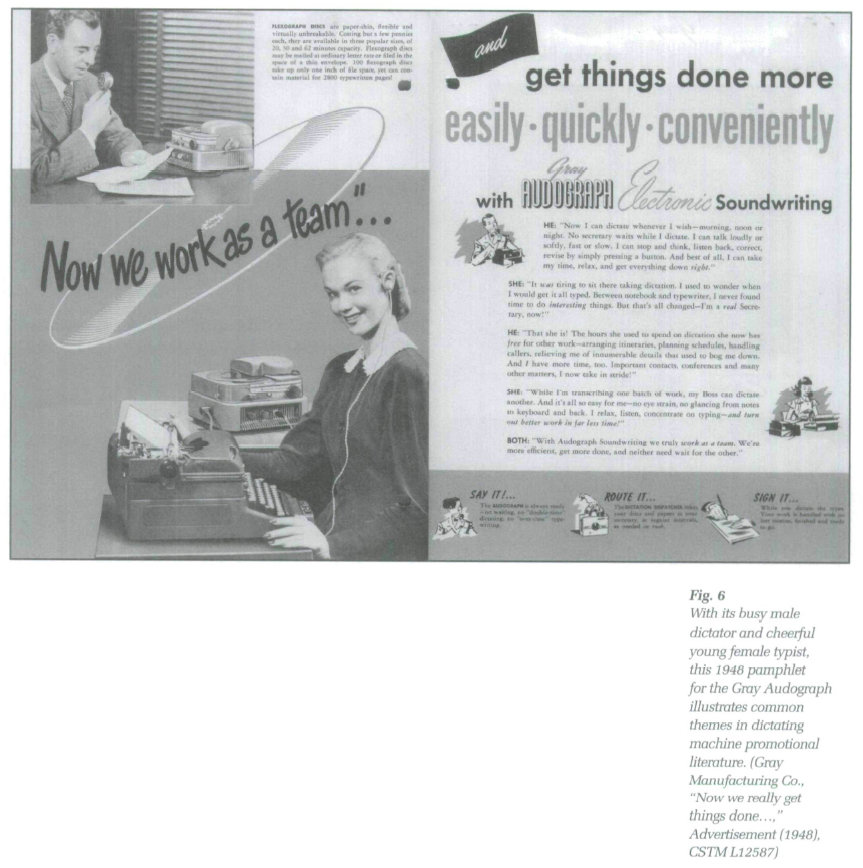 Display large image of Figure 6
Display large image of Figure 629 In trade journals like Office Equipment & Methods or business papers like the Financial Post, dictating machine suppliers promoted their products to insurance companies, banks, legal firms, and large institutions, organizations essentially in the business of information exchange. Words were a commodity whose flow must be facilitated. "Many businesses rely heavily on their ability to pour words out into the field," wrote a journalist for Office Equipment & Methods in 1957. "Unless these...are transcribed from thoughts into type or printed copy in the most efficient way, it can tie up expensive executive time."27 Promotional literature continued to repeat the themes first articulated by the North American Phonograph Company in the 1890s and the efficiency experts after the First World War (Fig. 6).
30 Dictating machine suppliers also continued to assume a gendered division of office labour. In the 1960s, the expression of this division took on a new tone. Dictaphone's advertisements in particular articulated for male managers a blend of desire and contempt for their female subordinates. A 1966 advertisement encouraged executives to take their machines home rather than work late, saying "It may not be as pretty as your secretary...but it doesn't quit at five." A particularly offensive advertisement for one of its belt recorders featured the headline "If your secretary can't read your writing, give her a belt." Dictaphone was not alone, however. A 1967 advertisement for IBM featured an attractive woman, gaze fixed on the reader and pencil seductively poised under chin and a headline that asked: "Is your secretary spending too much time in your office?"28
Centralization and Dispersal
31 The two important strategies for the dictating companies in the 1960s and 1970s were the sale of centralized systems and the marketing of portable devices. Whether phoned in or mailed in, the typist could now neither see nor question the author of the document being transcribed. The concept of centralized dictation systems was connected to that of typing pools and their supposed benefits of closer supervision of typists, precise monitoring of output, even distribution of workload, and elimination of idle time. The first such system would have been of the type proposed by Leffingwell, where the collection and distribution of cylinders and completed documents was done by messengers according to a schedule. In 1925, however, Dictaphone developed its Telecord central dictation system, which connected dictators to recorders via the telephone.29
32 This system reduced equipment costs by having relatively light users of dictation share a handful of recorders. As well, it eliminated the need for messengers to pick uprecordings and deliver them for transcription. Successful reductions in document processing times, however, also depended on systematic measurement of output, identification of authors and transcribers, assignment of priorities and distribution of workloads and tracking of job status. Toward this end of better job control, computer technology was introduced in the 1970s. In 1968, ten companies offered centralized dictation systems in Canada. These employed all the various recording formats. Although there were exceptions, most centralized dictation systems appear to have been installed in large business offices like banks, law firms and insurance companies, or in institutions like hospitals.30
33 The trade and general business press carried regular reports of companies that had adopted central dictation systems. In 1956 Office Equipment & Methods reported that the Whyte-Hook Paper Company of Toronto had reduced the time required to produce the manager's daily output of twenty letters from 350 to 150 minutes for the secretary and 150 to 36 minutes for the manager. In 1960 the British Pacific Life Insurance Company of Vancouver claimed a reduction in dictation time from 7 minutes for shorthand to 2 minutes; a 2 to 3 hour turnaround from dictation to signature; a more than 50 percent reduction in the cost of a letter; and a 20 percent saving in secretarial costs.31
34 While centralized systems were aimed at managers of large offices hoping to systematically reduce clerical costs, portable dictation was designed to serve a need for dictation while away from the stenographic services available in an office. Even though portables would appear, therefore, to be designed to solve a space problem (not being within earshot of a secretary or an office dictating machine) they also had a time dimension. Apart from the usual arguments about their cost effectiveness versus handwritten notes, manufacturers promoted portables for the option they gave of working outside normal business hours.
35 Dictating machines were made progressively lighter and more compact in the decades after the Second World War. Weighing 7.25 kg at the time it was introduced in the late 1940s, Gray claimed its Audograph was "the lightest dictating machine made."32 Slightly streamlined versions of other belt, disk and tape models were introduced in the 1950s and 1960s. For example, Edison introduced the Escort, a battery-powered portable weighing 3.4 kg in the summer of 1962. Dictaphone, Philips, Assman and Telefunken all promoted such machines by the mid-1960s. These were designed to be carried in a briefcase and run on a variety of power sources, including flashlight batteries or adapters plugged into car cigarette lighters.33
36 A distinct sub-class of portable dictating machines was the ultra-compact, pocket-sized model. These were introduced in the 1950s, perhaps the first being the Protona Minifon (1952), a general purpose wire recorder also used for surveillance. Dictaphone introduced the Dictet in 1956 (Fig. 7). This fully transistorized unit weighed about 1.2 kg and used a special cassette holding enough tape for sixty minutes of recording time. Another cassette-type magnetic recorder was the Mohawk Midgetape. While admirable for their degree of miniaturization, these machines were limited in their versatility. Although equipped with optional transcription features like earphones and foot pedal playback controls, none were compatible with standard desktop transcription equipment, and all were expensive. In 1962 the Midgetape retailed for $345 and the Dictet cost $368. This was cheaper than most other models in the Edison or Dictaphone lines but much more costly than many desktop, magnetic tape machines on the market.34
37 Beginning in 1966 the price and weight of handheld portable dictating machines dropped as manufacturers incorporated miniaturized, solid state circuit components. This caused a boom in sales. In 1967 Philips's new Pocket Memo 85 weighed just 340 grams and cost a mere $99.50. Unlike most previous ultra-compact machines, cartridges from the Pocket 85 could be transferred to Philips desktop transcribers like the model 84. This meant that field recordings could be mailed back to the office without requiring an identical machine for transcription. By 1968 DeJur introduced its Mini-Memo and Versatile III, both compatible with existing DeJur desktop transcribers and both priced at $89.50. By 1971, the Financial Post reported that demand for the inexpensive pocket recorders was "surging."35 In the 1970s handheld portables were introduced that employed one of the three industry standard cassettes.36
38 Portable dictating machines appealed to several kinds of users. In 1968 Daigle Lumber of Halifax equipped its travelling salesmen with Fi-Cord 101 and 303 portables. Employees on the road mailed taped product orders to head office for transcription. These machines could be used anytime and anywhere, resulting, the company believed, in saved time, increased productivity and improved accuracy in filling orders.37 The other type of user depicted in promotional literature was the busy and mobile executive or professional. Sometimes, the appeal was anxiety. An advertisement for the Lanier Pocket Secretary show a harried executive under the headline "What did you get done today?" Lanier offered him "new opportunities to get things done... Work on the way to work. At home. In a motel. Late at night. Any time. Any place."38 On the other hand, pocket-sized recorders also carried a certain status. According to the Financial Post the little machines gave the otherwise utilitarian dictating machine "a touch of much-needed glamour — they're associated with high-powered executives too busy jetting off to some place exotic to dictate to a secretary."39 By 1978, the Financial Post reported that portables and mini-portables accounted for thirty percent of new dictating units sold. In 1980, sales of portable units exceeded that of desktop units for the first time. Not only were they used on the road, they were popular in the same law firms, insurance companies, banks, government offices and hospitals that were the domain of desktop or centralized dictation systems.40
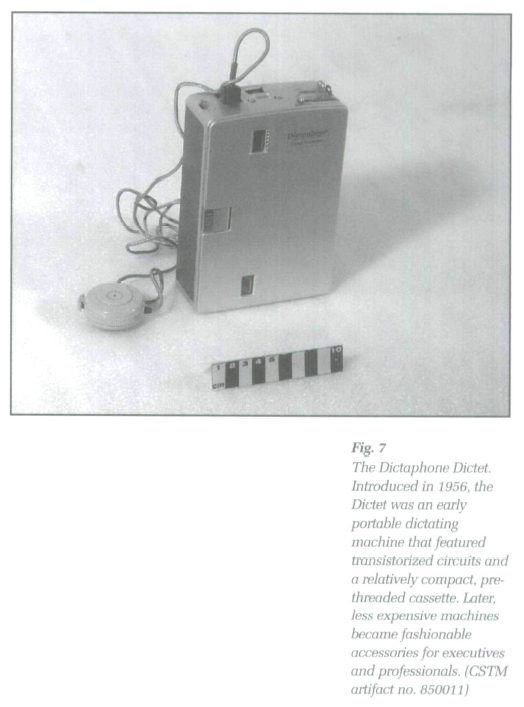 Display large image of Figure 7
Display large image of Figure 7A Truly Disappointing Situation
39 The growing popularity of inexpensive portable machines only momentarily brightened a discouraging stagnation in Canadian dictating equipment sales. While the quantity of machines and parts imported to Canada was two thirds higher in 1971 than it had been in 1966, an analysis of government trade statistics by Helen P. Graves Smith reveals that their value after inflation was actually less.41 The value of imports briefly spiked upwards in 1973-1975 but then declined steadily after that. In 1983 the real value of imports was about the same as it had been in 1960 (Fig. 8). In 1978, the president of Dictaphone Canada said the sales situation was "truly disappointing."42 One journalist described the dictating machine as "the Cinderella of the office equipment market, without the pizzazz of word-processing or the charisma of the computer."43 To make matters worse, an American marketing study concluded that two thirds of installed dictating units were no longer used.44 For years, Canadian sales representatives had complained that only a fraction of potential users had been convinced to buy their products. In 1960 a representative for IBM claimed companies had reached only twenty-five percent market penetration. Over the next two decades similar figures were frequently quoted, ranging from as low as twenty percent to a high of forty percent, with much of this variation depending on how the potential market was defined.45 In 1971 Office Equipment & Methods admitted that "dictating equipment has been going to take off for years, but never quite has."46
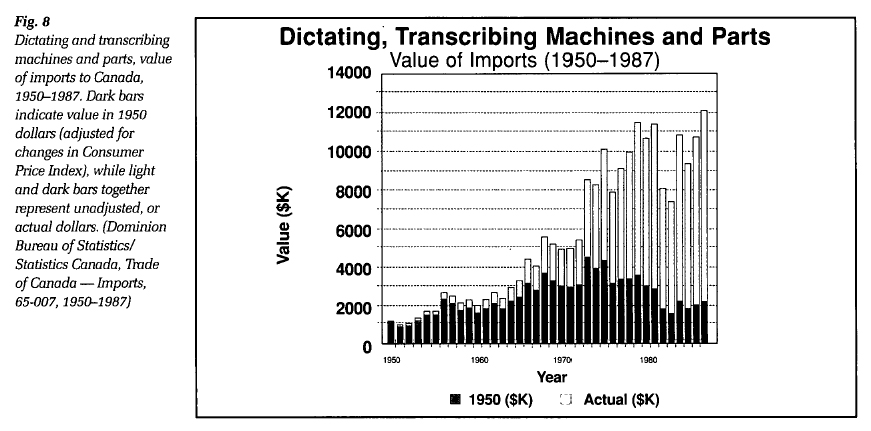 Display large image of Figure 8
Display large image of Figure 840 Without a doubt dictating machines were easier to use, more convenient, and provided better sound quality than the Dictaphones and Ediphones of fifty years earlier. But design innovations had failed to make a major breakthrough for machine dictations in the office equipment market. To some extent, equipment dealers blamed executives for reluctance to give up face-to-face dictation. Sometimes this was characterized pejoratively as "mike fright" or a vain reluctance to give up the prestige of a private secretary.47 According to the Financial Post, "user resistance, not technology, is the industry's major problem." The "technical updating of people" had not kept up with that of the machines. Despite years of depicting senior executives in manufacturers' promotional literature, Ralph Morris, president of Dictaphone Canada, admitted that "dictating equipment has been associated with lower management levels, those whose position didn't warrant a secretary to take dictation."48
41 Suppliers had long been convinced that the economic rationale for machine dictation was undeniable and that this alone would sell their products. In the 1970s many within the industry reluctantly concluded that the problem was the executive. If only he knew how to dictate, the system would deliver its benefits. But to their dismay machine dictation was a learned and perhaps uncommon skill. In 1976 Office Equipment & Methods interviewed several secretaries on the subject of dictation. Those who preferred machine dictation emphasized the importance of having a boss who was "articulate and well-organized." In the words of one anonymous secretary, the executive "must be a good dictator or the whole point is lost."49 In belated recognition that dictation was not as natural as had been assumed, most major dictation machine suppliers in the 1970s began to offer training courses for authors and typists.50 According to Mike Oke, marketing manager for Dictaphone Canada, it took "about one or two weeks for someone to be totally conversant with dictating equipment." Oke admitted that "some people never [did] get on to it" but this was usually because they did not "try hard enough."51
42 But this unwillingness to "try hard enough" may simply have reflected a more fundamental resistance to the process of machine dictation. Tim Holmes, marketing manager for Philips Electronics, admitted in 1979 that "there's a basic resistance just to speaking into the thing ... It's not the simplest thing in the world for some people."52 Back in 1962, Ronald Kent, president of Dictaphone in Canada, had said that "your microphone catches your thoughts just as quickly and just as accurately as you express them." Machine dictation gave the manager the ability to communicate "simply by writing out loud."53 From the 1907 Edison advertisement, "From Brain to Type," through Galloway's separation of "thinking and planning" from "doing" to Dictaphone's "Thought Tank," machine dictation advocates assumed that the ideal system involved a manager formulating thoughts in isolation and speaking their final written form into a recording device. "The ultimate aim of the modern businessman," one sales representative told the Financial Post in 1963, "is to be able to dictate into a device which, simultaneously, types the oral message."54
43 But what if this vision was based on a misunderstanding of how many people composed written documents? What if it did not fully describe the complex mental and communicative processes involved in composing and typing a letter, let alone a more complicated document? In the 1970s equipment salesmen liked to say their biggest competition was from the pen. Despite years of emphasizing that machine dictation was competing with shorthand dictation, one marketing manager for Philips Electronics admitted in 1979 that handwritten drafts were "by far the most popular" means of composing letters for transcription. The inability to wean people off longhand drafts was called by another "a general industry failure." The product manager for Sony of Canada even suggested that the only way to beat the competition of pen and pencil was for management to force their staff to use dictating equipment. Yet an expert on office automation argued that it was just this sort of compulsion that soured office workers on machine dictation.55
44 Most managers and other office workers were more comfortable creating written correspondence in written form, rather than as verbal approximations of the final written form. To them, the dictating machine must have felt awkward, and machine dictation a skill that was not easily acquired. One only has to read the manufacturers' advice to dictators to understand how inhibiting machine dictation might be for many authors. The operating manual for the Audograph gave elaborate instructions for both the manager and the stenographer. The manager was counselled to speak in a "normal conversational tone" and use "voice inflection" to convey meaning. But at the same time he was also to dictate all punctuation and carefully enunciate or spell out unusual names. Moreover, even before starting dictation, the manager should have organized his material and have had a "mental outline" of the "structure and content" of the letter. The stenographer, on the other hand, was instructed to remember the "characteristics and personality of [the] individual dictator," as all his letters would "follow a common pattern." When still in doubt about a particular passage, she was to seek clarification from the dictator.56
45 The necessity for such detailed instructions reveals not only the differences between spoken and written discourse (most obviously in such conventions as verbal inflection, spelling and punctuation)57 but also suggest an unacknowledged degree of collaboration by the stenographer or secretary in the creation of the document. Machine dictation was predicated on the assumption not only that typing was a purely mechanical skill, but that the shorthand stenographer was simply a neutral receptacle for information imparted by the dictator, easily replaced by a mechanical or electrical recording device. Yet many senior executives who employed personal secretaries depended on them for feedback on the composition, of documents. Machine dictation imposed a oneway information flow and sequence of events on what was traditionally a two-way or shared process that involved simultaneous as well as sequential action by two individuals.
46 In 1979 a journalist interviewed William Gibson, director of training for St John Ambulance, and learned that it was "sometimes useful to have a secretary's response to dictation, someone to query a meaning or help find the right word, particularly when dictator and secretary are used to working together."58 In 1976 Frances Walters, a Montreal secretary with many years of experience, told Office Equipment & Methods that "dictating must be on a one-to-one basis to be successful." When her employer committed errors in sentence structure or misplaced a word or phrase during shorthand dictation, she sought clarification or correction by using "facial expressions as a 'silent feedback'." Jean Young, also of Montreal, vowed she would quit if her employer adopted dictating equipment. She placed great stock in the personal working relationship and collaborative work of producing correspondence in face-to-face dictation. "When you've worked with a particular man for some time you get to know him. How he thinks. How his business associates react. So when you're taking a letter you know instinctively when something should be changed. When you're face-to-face, this takes a minute. But if it was on tape I'd re-type it. Frustrating and time-consuming for both of us." In fact, Barbara Cooper, an executive secretary in Toronto, was so convinced of the instrumental role she and her colleagues played that she saw no reason why they could not "answer their bosses' correspondence themselves." This certainly did occur, at least for routine correspondence. But even if the secretary was not an active participant in the composition of a document, rapid and accurate transcription of dictation could be hindered by a lack of communication with the author. Diane Thorpe, of Toronto, resented having to decipher words off a tape without being able to direcdy query the author. She preferred face-to-face dictation for "its greater clarification."59
47 The speed of transcription from machine dictation was greatest when the typist could produce a final document on her first hearing of the recording. In practice this was very difficult to achieve. Before beginning, the typist needed information about the recording that was not embedded in the recording itself. She needed to know what kind of a document it was (letter, internal memo, report, form, etc.), how long it was, what special stationery or form should be used, and what level of priority that it should receive among the other recordings. As well, she had to be warned of any corrections or additions, especially where the error had not been erased and the amendments were out of sequence. As seen with the Audograph, equipment manufacturers generally incorporated a system for indicating the starting point for separate pieces of dictation on a disk, belt or tape. As well some could indicate the presence of corrections or special instructions for priority items. These systems were in the form of handwritten slips filled out by the dictator, paper indexes that were marked when the dictator operated controls on the machine, or such electronic signals as tones or flashing lights. Many of these systems, however, depended on their conscientious use by the dictator.60 An anonymous Toronto woman complained to Office Equipment & Methods in 1976 that executives consistently failed to provide this critical information. As a result the secretary had to listen to the entire tape before typing in order to determine the length and relative urgency of each letter. Francis Walters concluded that dictation equipment was "both inefficient and time-consuming." The typist had to play the tape twice, first to "get the gist" and again to transcribe it. Then her boss would have to review and correct the draft, which would then be retyped, and then read again by the executive before applying a signature.61
48 Some office efficiency experts acknowledged that machine dictation was not the best choice in all situations. One said that "reactive dictation" (reply letters, or filling out forms) was more suited to mechanical methods than "creative dictation."62 Another pointed out that, while shorthand dictation did not make efficient use of a stenographer's time, it was probably the fastest method for the author, and that transcription time was about equal to that for recordings. Longhand drafting, though slow in origination and transcription, had the significant advantage of allowing the author to review his or her work. This was important for individuals unaccustomed to writing letters or who were writing very long reports.63
49 Some of the problems of transcription from machine dictation were addressed by the new technology of word processing. If an initial typing could be stored in memory and then edited after corrections and clarifications, then no time was lost in a second typing. In 1982 Christine Arcare, a senior clerk with Royal Trust's Montreal office, praised the use of machine dictation and word processing as the "perfect combination." Even if the author were a poor dictator, "now I get it all on the screen, clean it up, and away we go."64 The era of word processing began with the introduction of the IBM Magnetic Tape Selectric Typewriter (MTST) in 1964. By 1971 word processing or, "automatic typing" hardware, software or supplies were offered by fifty manufacturers. Dictating machine companies hoped to capitalize on the growth in word processing by promoting dictation machines as the "natural input medium." In 1980 four companies, AES, Philips, Dictaphone, and IBM, included both dictating equipment and word processors in their product lines. Despite their attempts to market them as integrated systems, however, dictation equipment sales did not match the growth in word processor shipments.65
50 Dictation equipment suppliers also hoped to capitalize on the introduction of the desktop computer. Not surprisingly, they anticipated that machine dictation would be replaced by a speech recognition interface with the computer. As early as 1959, Ray Lister, general manager of Thomas A. Edison of Canada, predicted a system for "remote control dictation" in which a letter would be dictated "straight into a machine" where it would be "typed and...ready for signature five minutes later." This forecast was repeated frequently over the next twenty years.66
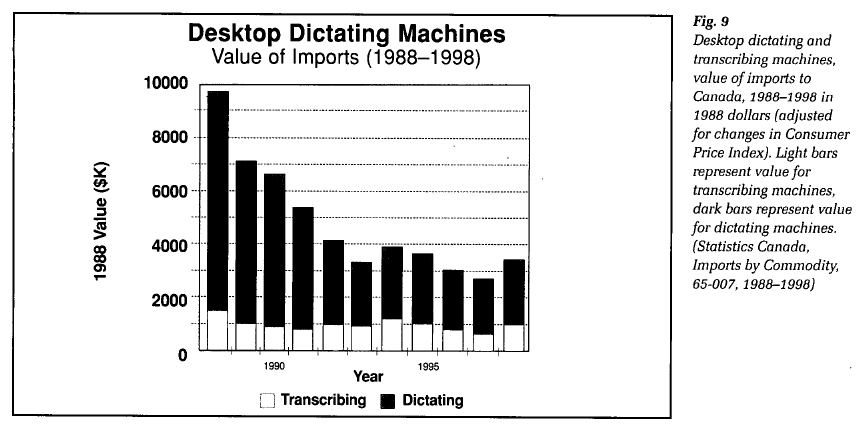 Display large image of Figure 9
Display large image of Figure 951 It is interesting that these predictions assumed that non-clerical staff would use voice input, possibly supplemented by a light pen, to prepare documents on their computers. Typing was too closely identified with female, clerical labour, and the machine dictation companies were firmly entrenched in the old division of labour and the manager's customary tools of spoken command and authoritative signature. Yet in the 1980s when employers began to place personal computers on desktops in large numbers, non-clerical staff learned the keyboard skills necessary for entering text. It is notable that as sales of personal computers soared in the late 1980s and the 1990s, Graves Smith's analysis of trade statistics demonstrates a continued decline in imports of desktop dictating machines67 (Fig. 9). The division between document creation and document preparation was now blurred. Millions of managers, professionals and clerical workers composed texts at the keyboard, viewing and editing on a video screen.
Conclusion
52 Machine dictation did not disappear. It continues to be used in some situations, most notably in medical record keeping and legal case work. As well, speech recognition continues to attract the interest of surviving dictating machine companies and software developers. While products are available on the market, speech recognition has developed more slowly than anticipated. The problem of "teaching" a computer to recognize the unique quality of an individual's voice, distinguish countless homonyms, and render unphonetic spellings and novel proper names resembles that faced by typists transcribing recorded dictation: much querying and correction is required.
53 The dictating machine was the product of a particular historical approach to the organization of office work and management of time: the separation of creative work from mechanical tasks, the allocation of the mechanical tasks to specialized, low-paid workers and the structuring of the labour process to maximize product flow, minimize interruptions and eliminate idle time. The production of office documents, however, proved difficult to reorganize and mechanize. Recorded utterances were not easily transposed into acceptable text. The characteristics of face-to-face dictation, including non-verbal cues, direct inquiries, and tacit collaboration, were not easily mechanized. A co-operative, simultaneous activity was not easily restructured as a discrete sequence of tasks by isolated individuals. The advent of the personal computer re-established the link between document creation and document preparation. In so doing, it also rendered the old face-to-face encounter of shorthand dictation unnecessary. In fact, documents could be created without the assistance of a typist, stenographer or secretary at all. In a way, this is a fulfillment of the ambitions of scientific management. Aside from keyboard entry, all other stenographic functions have been assumed by software and hardware. Whether the elimination of a collaborator's input has improved the quality of texts is an open question.
I would like to thank Dr Helen P. Graves Smith for her invaluable assistance in the preparation of this paper. In addition to locating references in the Financial Post and Office Equipment & Methods, Dr Graves Smith collected and adjusted the statistical data and generated the graphs in Figures 8 and 9. I would also like to thank her for her comments on the first draft of this paper.